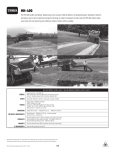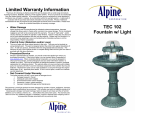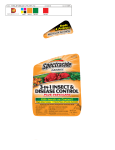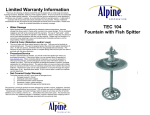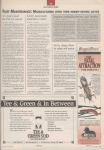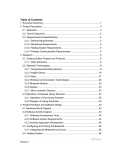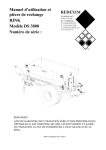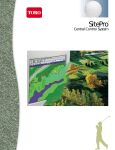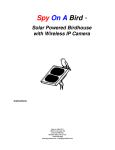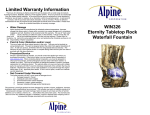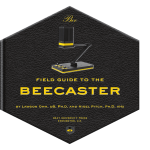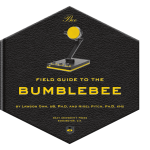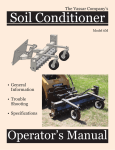Download Pesticide-Free Zone Sign Owner`s Manual
Transcript
Pesticide-Free Zone Sign Owner’s Manual Congratulations on your purchase of a Pesticide Free Zone lawn sign! You are setting an excellent example for your neighbors by not using hazardous pesticides, and you have a right to be proud. We hope you display your sign right away and share your philosophy and techniques with your family, friends and neighbors. How to Display the Pesticide-Free Zone Sign The Pesticide Free Zone (PFZ) sign can be mounted on a flat surface, like a fence or a wall, or onto a stake in the ground. The two holes in the sign can accommodate screws (#10 are ideal), nails, wire, or string. The important thing is to place the sign where people can see it. Source: Washington Toxics Coalition What Does Pesticide-Free Mean? Ideally, pesticide-free means that no chemical weed or insect controls are used on your lawn at all. We believe that if you work to prevent problems using good practices, you should not have major problems that require drastic measures. If controls are desired, we consider the use of natural/organic materials such as corn gluten, botanicals, and biological controls or least toxic materials like fatty-acid or insecticidal soaps, to be consistent with the PFZ sign. Of particular concern are toxic pesticides associated with cancer, developmental and learning disabilities, Beyond Pesticides nerve and immune system damage, liver or kidney damage, reproductive impairment, birth defects, or disruption of the endocrine (hormonal) system. Commercial pesticides that are exempt from registration with the Environmental Protection Agency (EPA) are generally compatible with our philosophy. The use of the sign is based on the honor system, and we do not ask or monitor what materials you use. If you feel that the sign reflects your practices, you should display it. If you have questions about the suitability of certain products, please feel free to call Beyond Pesticides at 202-5435450. What’s So Bad About Pesticides? The EPA states that, “By their very nature, most pesticides create some risk of harm to humans, animals, or the environment because they are designed to kill or otherwise adversely affect living organisms.” 1 We advocate safe, healthy, LIVING lawns and landscapes that nurture the ecosystem while also providing a pleasant landscape for you and your family. Given the plethora of pesticides – mostly insecticides, herbicides (weed killers), and fungicides, in our air, food and drinking water, it is not surprising that pesticides are a major concern for chronic disease and environmental contamination. Here are a few facts about pesticides and lawn care: Of the 30 commonly used lawn pesticides, 13 are ‘probable’ or ‘possible’ carcinogens, 14 are associated with birth defects, 18 with reproductive effects such as reduced sperm counts or infertility, and 20 with liver or kidney damage. 18 can cause neurotoxicity, which impairs the central and/or peripheral nervous system resulting in a range of problems from the ability to learn to chronic fatigue. 11 are suspected endocrine disruptors.2 Children take in more pesticides relative to body weight than adults and are less able to detoxify toxic chemicals. 3 701 E Street, SE, Washington, DC 20003 * Tel. (202) 543-5450 Fax (202) 543-4791 Email: [email protected] * Web: www.beyondpesticides.org 2 A child in a household using home and garden pesticides has a higher risk of developing leukemia by more than six times. 4 Exposure to herbicides before the age of one is linked to a four-fold increase in childhood asthma. 5 Suburban lawns and gardens use more pesticides per acre than agriculture. 6 Lawn and landscape pesticides drift and can be tracked into homes where they are inhaled and ingested and can remain for up to a year. 7 Dogs exposed to herbicide-treated grass such as 2,4-D and other week killers have increased risks of bladder cancer and lymphoma from two to seven times respectively. 8 Of 30 commonly used lawn pesticides: 17 have been detected in groundwater, 23 can leach into groundwater, 16 are toxic to birds, 24 to fish and aquatic organisms, and 11 to bees. And 11 may disrupt the hormonal system in wildlife. 9 Talking to Neighbors About Pesticides After displaying your sign, you may get some questions from your neighbors about why you are displaying the sign, why you do not use pesticides, or how you manage pests without chemicals. Here are some tips for talking to your friends and neighbors about pesticides: 10 • Emphasize human health – Most people are concerned about the human health implications of pesticide use – and not necessarily the threat pesticides pose to wildlife or the environment. So, while poisoned songbirds are a powerful symbol of the dangers, they may not move everyone to action. What does move many people is the idea that the use of hazardous pesticides can cause cancer and other health problems in their in children, pets and other loved ones. Do not worry if you do not know all the facts to answer their questions, the uncertainty or risk factors speak loudly. Beyond Pesticides • Stress Cost-savings – Using fewer pesticides can save money by replacing expensive chemicals with less expensive pest prevention techniques, such as integrated pest management (IPM). IPM gets at the root of the problem and can eliminate the need for pesticides. It is a program of prevention, such as paying attention to healthy soil; monitoring, such as knowing when bug or weed levels become pests; and control, such as weed pulling. • Use reasonable language - The public does not trust advocates who use heated rhetoric. Your words should be balanced, logical, and somewhat unemotional. That does not mean you cannot speak with conviction; it just means you should consider your tone of voice and body language when telling your story. There is no quicker way to turn off a listener than by being overly serious or selfimportant. A sense of humor, for example, can be a great asset. • Keep it simple - Technical and scientific arguments do not always sell in the public marketplace of ideas. Too often they confuse people rather than convince them. Ground your arguments in common sense - use relatively simple ideas that do not require technical expertise to understand or agree with. After all, you do not want to lecture your neighbors, you just want to have a conversation. • Follow up - If your neighbors or friends seem interested in what you are saying, offer to bring them additional information. To find information, articles, or factsheets about pesticides and lawn care, visit our website at www.beyondpesticides.org or give us a call. KEY FOCAL POINTS Children are more vulnerable than adults. They are smaller, eat and drink more per pound, are still developing, and have behaviors that put them at risk (playing on the grass, mouthing their hands, going barefoot, etc.). • • EPA-Registered Does Not Equal Safety. The Environmental Protection Agency (EPA) is the first to 701 E Street, SE, Washington, DC 20003 * Tel. (202) 543-5450 Fax (202) 543-4791 Email: [email protected] * Web: www.beyondpesticides.org 3 say that registration of a pesticide does not mean it is “safe.” EPA recommends people avoid pesticides when possible. All studies provided to the agency for registration of a pesticide are submitted by manufacturers who have a vested interest in the outcome. EPA uses a “risk/benefit” approach that subjectively pits economic benefits of a pesticide against the potential harm. All pesticide formulations contain an active ingredient, the chemical that is specifically designed to poison and kill the pest, and inert ingredients that make the pesticide last longer or more potent. Inert ingredients make up the majority of the product and are not disclosed on the label, yet they can be just as toxic as the active ingredient. Testing is only done on active ingredients, not on exposure to the actual product formulation. Health effects from multiple chemical exposures or combined pesticides (as typically found in lawn products) are also not considered. • Effective alternatives are readily available. Most garden stores stock some organic/natural products for garden and lawn care. You can ask your neighbor what their major problems are and focus on alternatives for those pests. For example, if their biggest problem is weeds, you can give them a weed management or other alternatives factsheet. If your neighbor hires a commercial service, inform them that some lawn care companies offer an organic or low-pesticide approach. Even if such a program is not locally available, consider bringing your neighbors together informally to share information. Information on lawn care companies offering leasttoxic services are available on the Beyond Pesticides website, under “Safety Source.” How to Maintain a Pesticide Free Lawn Develop healthy soil. Sample the soil with a “soil probe” – cut or dig a small hole about 10” deep and with one side that is straight and smooth. The lawn should have between 5”-6” of topsoil, which is the darkest soil layer. If needed, add topdressings of Beyond Pesticides organic matter, such as composted manures (they do not have an odor), to the topsoil. Plant well-adapted, pest-resistant grass varieties. You can find out which grass is most suitable to your climate from your local cooperative extension. A mix of two or more grass varieties is preferable. Overseeding, or planting additional seeds in already established lawns, has been shown to reduce weed problems in some cases. Aerate the lawn twice a year. Soil compaction is one of the largest causes of weed problems. Aerating, or removing small cores or “plugs” of soil, allows air, water, and nutrients to reach the roots of the grass. Most lawns should be aerated. You can rent an aerator and share costs with neighbors. De-thatch. Thatch is a dense layer of grass stems and roots on the surface of the soil. When thatch layers become ½” or more, the roots will grow up within the thatch instead of establishing themselves deep into the soil, making grass susceptible to insects, disease, and weather stress. Thatch is reduced by aeration, topdressing with organic matter, or by vertical mowing, which requires special equipment and will result in temporary aesthetic damage to the lawn. Maintain proper pH. Test your soil and adjust the pH if necessary. Low pH means high acid content – add lime to raise the pH and lower the acidity. High pH means high alkaline – add sulphur to lower the pH, taking care not to add too much and burn the 701 E Street, SE, Washington, DC 20003 * Tel. (202) 543-5450 Fax (202) 543-4791 Email: [email protected] * Web: www.beyondpesticides.org 4 lawn. Watch for hints of pH imbalance such as a dandelion infestation. Dandelions love soil with a 7.5 pH, while most grass varieties prefer a pH of 6.7 7.0. Nothing will successfully conquer a dandelion problem without a correction of the lawn’s pH. Fertilize. Use a slow release fertilizer formulation once a year, usually in the fall, to increase the efficiency of nutrient uptake and reduce nutrient runoff and leaching. Fast-release fertilizers can induce pest outbreaks. Avoid synthetic chemical nitrogen-rich fertilizers that can kill valuable microorganisms in the soil and feed only the grass not the soil. The best way to determine your lawn's nutrient needs is by a soil test. As a general rule however, use a natural/organic fertilizer with a balanced ratio of numbers close in proximity, such as 5-3-4. Watch for signals from your lawn. Learn to read signals. For example, if clover is taking over the lawn, chances are the soil is lacking nitrogen since clover gets nitrogen from the air and grass gets nitrogen from the soil. Water properly. Over or under watering can induce pest outbreaks. Enough water should be applied each time to wet the soil to the depth of the grass root zone and be nearly dry before watered again. Avoid frequent, shallow waterings, which promote shallow root systems and reduce stress resistance. Natural, organic fertilizers can increase the water-holding capacity of the soil. Mow correctly. Mow with sharp blades set to 3” to minimize adverse effects and retain the lawn’s competitive ability. Never cut more than 1/3 of the grass blades in a single mowing and leave a light layer of grass clippings on the grass, as they can provide up to half the lawn’s nitrogen requirement. Rotate the mowing pattern to reduce lawn compaction. Mow frequently enough to ensure that weeds are unable to build up energy reserves and become well established. Weeds can also be pulled by hand. If you feel that an herbicide is necessary, corn gluten is an excellent pre-emergent, and a fatty-acid soap is an effective broad-spectrum herbicide. Beyond Pesticides Insects. Your control strategy will depend on your particular pest problem. You can control grubs over time by applying the bacterium Bacillus papillae (milky spore disease), which, once established, will provide control for decades. Kill chinch bugs by drenching the thatch layer with an insecticidal soap. Sod webworms can be controlled by de-thatching and applying Bacillus thuringiensis (Bt) when larvae are present, applying nematode parasites, or with insecticidal soap. Although considered least-toxic, insecticidal soap is toxic to most insects when they are drenched with it, and Bt is toxic to caterpillars. Disease. Disease problems are often the result of improper nutrient or moisture conditions. For example, dollar spot, a common lawn fungus, thrives on lawns with insufficient levels of nitrogen. The key to preventing lawn disease is to use locally adapted, resistant varieties of grass. How to Grow an Organic Garden There are several considerations in setting your own garden and tending it organically. The first is deciding on what type of garden you want or are able to have and where best to locate it. If you are in an urban environment with limited space or contaminated soil, you might consider a small container garden on a porch or patio or perhaps renting a community garden plot. If you do have space on your own property, you want make sure the site for your garden fits your needs in terms of size, shape, sun/shade requirements, and, most importantly, healthy, fertile soil. A good pH and high nutrient content are key issues to be looked at when first deciding on a plot. A good way to build up your own soil fertility is to compost your kitchen and garden scraps and incorporate it into your soil. Growing a good variety of crops and rotating them so that they are not planted in the same space year after year is good way to keep up your fertility once you have built it. Prevention. To prevent pests and disease from overtaking all of your hard work, there are prevention strategies you can employ. Certain 701 E Street, SE, Washington, DC 20003 * Tel. (202) 543-5450 Fax (202) 543-4791 Email: [email protected] * Web: www.beyondpesticides.org 5 varieties of plants are naturally pest-repellant, such as rosemary, and will help to deter insects from your garden. Harnessing beneficial insects, including pollinators such as honeybees, is an integral part of maintaining a healthy garden. In fact, the best defense against pest and disease problems is to ensure that your plants are healthy and well-fed. Plants, like people, will be best able to fend off any invaders if their immune systems are fully functioning. Treating Problems. When, despite all your best planning and preparation, pest or disease problems inevitably strike, there are still ecologically sensible ways of managing them. Carefully monitor pest activity and be sure you have identified the problem. Aside from employing the usual mechanical and hand weeding methods for keeping out unwanted plants, you can help by harnessing beneficial soil micro-organisms as well as pest predators. Finally, if you’ve tried everything else and have truly nowhere left to turn, there are a few least-toxic or non-toxic chemicals that you can use in targeted treatments. These should only be used if you are sure that they will treat your specific problem and only in the amount that you need. For a more in-depth description of everything involved in growing an organic garden from site preparation to harvest, see “Grow Your Own Organic Food” from our Spring 2010 issue of Pesticides and You. How to Protect and Encourage Pollinators In addition to keeping your property organic and ensuring that there are no toxic substances which may harm bees and other pollinators, there are several steps you can take to attract these beneficial insects to your garden and protect them and their habitat. Like any other living organism, bees need food, water, and shelter in order to thrive. This will not only provide habitat and sustenance to the pollinators, but will also help your plants to flower more plentifully. Bees are attracted to most flowering plants, and are especially fond of blue and yellow flowers. Other colors such as purple, white and pink also serve to attract bees. Make sure there are plants that will flower during different parts of the season to keep your garden flourishing throughout the summer and well into fall. This serves to provide a steady supply of nectar and pollen for bees. A diversity of flowers planted is close proximity to each other strongly attract bees. Gardens with 10 or more species of flowering plants attract the greatest number of bees. The best plants are those native annual and perennial wildflowers which naturally grow in your region. Water. Bees also need sources of water. Water can be provided in very shallow birdbaths or by adding a quarter inch of sand to a large saucer, such as those designed to fit beneath clay flower pots. Fill the saucer so that the water rises about a quarter inch above the sand. Add a few flat stones, some should rise above the water and some should just touch the surface. These stones will allow bees and other insects to drink without drowning. To avoid creating a mosquito breeding site, be sure to change the water at least twice a week. Housing. Many bees do not live in hives or colonies. By creating an ideal nesting site, you can attract species to nest and hibernate in your garden. Bumblebees, for example, hibernate and nest in abandoned rodent nests, birdhouses, snags and logs. They also are attracted to piles of cut vegetation, compost heaps, and mounds of earth and rubble. Leaving some areas in your garden bare, preferably in a sunny location, provides other ground-nesting bee species areas to dig tunnels into the soil to create nests. Brush piles, dead trees, and some dead branches or dried pithy stems attract stem-nesting bees such as leafcutter bees, while others such as the blue orchard bee prefer to use mud to build their nests. Food. You can begin by planting a bee garden filled with flowering varieties that will attract the bees. Beyond Pesticides 701 E Street, SE, Washington, DC 20003 * Tel. (202) 543-5450 Fax (202) 543-4791 Email: [email protected] * Web: www.beyondpesticides.org 6 Beekeeping. For those who may be feeling highly motivated, there is also the option of keeping your very own colony of bees in your backyard. Although not all bees live in hives, certain species, notably honeybees, are easily and safely kept in artificial hives for their shelter. This provides a safe haven for the bees while also allowing you the opportunity to harvest the fresh honey! Aspiring beekeepers must decide which subspecies of honeybee to acquire and purchase protective equipment. If you are interested in keeping honeybees, the American Beekeeping Federation recommends that you find a local bee club in your area. Most clubs either offer courses in basic beekeeping or can direct you to such courses. These are often given at the beginning of the year, in order to prepare people to start their hives in the spring. Be sure to look for those offering organic beekeeping, so that you can be sure that your bees are not being exposed to any harmful substances. For more information on keeping your own bees, see the “Backyard Beekeeping” article from the Fall 2009 issue of Pesticides and You. References: 1 U.S. EPA, Office of Pesticide Programs. “What is a Pesticide?” 2002. http://www.epa.gov/pesticides/about/. Beyond Pesticides. Health Effects of 30 Commonly Used Lawn Pesticides. March 2005. 3 U.S. EPA, 1996. Office of the Administrator. Environmental Health Threats to Children, EPA 175-F-96-001. 4 Lowengart, R. et al. “Childhood Leukemia and Parent’s Occupational and Home Exposures.“ Journal of the National Cancer Institute. 79:39, 1987. 5 Boise, Phil., et al., “GreenCare for Children. Measuring Environmental Hazards in the Childcare Industry: Pesticides, Lead, and Indoor Air Quality,” Community Environmental Council. 2004. 6 National Research Council, National Academy of Sciences, Urban Pest Management, 1980. U.S. EPA officials currently acknowledge this phenomenon in interviews. 7 Nishioka, Marcia G., et al. 2001. “Distribution of 2,4-D in Air and on Surfaces inside Residences after Lawn Applications: Comparing Exposure Estimates from Various Media for Young Children,” Environmental Health Perspectives, 109(11), November. 8 Glickman, L. et al. 2004. J Am Vet Med Assoc. 24:1290-1297. Hayes HM. 1991. J Natl Cancer Inst. 83(17): 1226-31. Hayes HM, et al. 1995. Environ Res. 70(2): 119-25. 9 Beyond Pesticides, Environmental Effects of 30 Commonly Used Lawn Pesticides, April 2005. 10 Adapted from David Malakoff, “Getting the Message Across,” Pesticides and You, Beyond Pesticides. 1994. 2 Beyond Pesticides 701 E Street, SE, Washington, DC 20003 * Tel. (202) 543-5450 Fax (202) 543-4791 Email: [email protected] * Web: www.beyondpesticides.org 7









